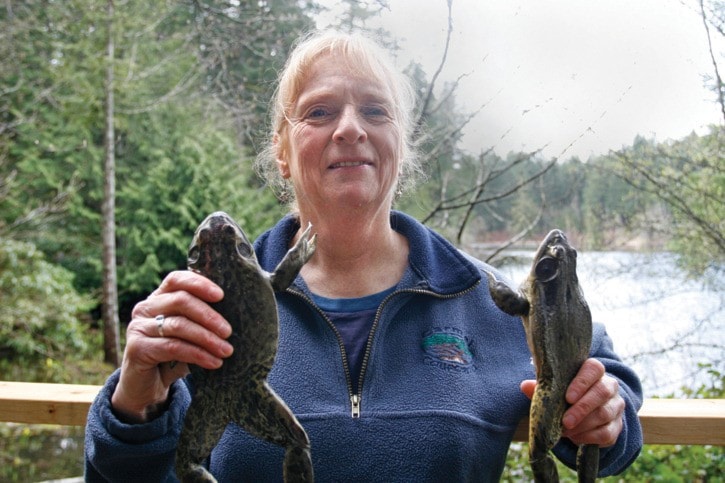Pattie Whitehouse and Neville Grigg are going toe-to-webbed toe with American bullfrogs hopping around Highlands.
This year marks the sixth year the pair have scoured Highlands lakes for the invasive and yet evasive species.
“In 2006 Neville and I started making regular patrols of the lake,” Whitehouse said. “We don’t worry too much about the tadpoles, our main thing is to get the mating frogs. When we hear a male calling (for a mate) we’ll go out.”
Whitehouse and Grigg live across from each other on Teanook Lake. Before starting their personal eradication project, Grigg described the lake as “bullfrog soup.”
“You couldn’t swim in the lake without bumping into tadpoles,” Whitehouse said.
Grigg was also concerned over water safety, as the lake is his family’s water source. “Bullfrogs carry salmonella and other harmful human pathogens,” Whitehouse said.
When Whitehouse and Grigg set out on their evening bullfrog expeditions, Grigg sits at the front with an ultra-bright flashlight and shines it along the shoreline to catch a bullfrogs eyes’ reflection.
When a bullfrog is spotted, Whitehouse steers the canoe toward the amphibian and Grigg uses a frog spear to catch the intruder. The bullfrog is then put in a bucket of water and clove oil.
“The clove oil is a natural anesthetic,” Whitehouse explained.
Frogs are placed in a fridge, and the cool temperatures send the frogs into hibernation. They are then transferred to a freezer where they perish.
“We’ve noticed this year in particular there are far more tree frogs calling,” Whitehouse said, explaining that means there has been a decrease in bullfrogs in the area.
Bullfrogs eat navitve frogs, ducklings, birds, salmon, the endangered Western painted turtles, other native fauna and anything else that can fit in their mouths.
Whitehouse, Grigg and other volunteers hunt bullfrogs on various lakes in Highlands, such as Matson, Mary, Mitchell, Second, Third, Pease and Eagles lakes.
Property owners living on Fork and Fizzle lakes have always carried out their own eradication programs, Whitehouse said.
“When we first started going out, we would get a dozen or so a night. Now on a big night we might get four or five,” Whitehouse said.
About 12 residents in Highlands are trained in bullfrog eradication. Whitehouse and Grigg hope to train more people this year as well. Volunteers in the program are part of the Highlands Stewardship Foundation.
“We are getting more equipment and hoping to expand this program,” Whitehouse said.
While the volunteer group has been successful in decreasing the bullfrog population, they sometimes call for backup.
Biologist Stan Orchard has been operating his own bullfrog eradication program throughout the Capital Regional District, with a focus on Langford, and is hired by municipalities to hunt for the croaking frogs.
When Orchard is out on the lakes at night, he travels by a Zodiac inflatable boat and stuns the frogs with his “electrofrogger,” an electric shocking device he created.
Orchard is called when conditions on the lakes make it tricky for the volunteer group to work, such as when there are too many weeds to maneuver a canoe, Whitehouse said.
“My system is a bit more efficient than the system they use,” Orchard said.
A challenge Orchard faces working in Highlands is the lakes are harder to get to than those in an urban setting. “The margins of the lake are less easy to get to, and I have to carry equipment farther,” Orchard said. “Lakes in Highlands are less manicured than urban lakes.”
For the bullfrog hunting season, May until September, Whitehouse said she and Grigg hope to host public education evenings for residents to learn about American bullfrogs, the problems they cause and how to properly identify them.
In 2010, Highlands council gave $4,400 to Orchard to help assist in the eradication efforts. The volunteers working with the Highlands Stewardship Foundation were given $3,200 to help with equipment costs.
Any Highlands resident who hears a bullfrog near their home can contact Whitehouse at pattie@pacificcoast.net.
reporter@goldstreamgazette.com
